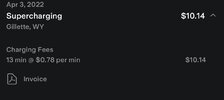No, you wouldn't be charging for electricity consumed, you'd be charging for the time spent at each tier, according to the table of rates, which just so happens to be somewhat correlated with the amount of electricity consumed. But you're not measuring amount consumed and charging for it, you're measuring power and charging by time.
There is still a correlation between how much you actually consumed and how much was charged. The word
correlation means that there is a statistical relationship between two variables -- in this case, the power being drawn and the amount being consumed. "No direct correlation" would mean that there's a
correlation coefficient of zero, meaning that the two variables are entirely unrelated. This isn't the case. While the 4 tier system may have a correlation coefficient of say 0.7, the 250 tier system may have a correlation coefficient of 0.99. But legally, there is no difference between a correlation coefficient of 0.7 and a correlation coefficient of 0.99. You're not charging by amount consumed unless the correlation coefficient is exactly 1.00, and if 4 tiers are okay, then 250 tiers are okay as well. Even under the 250 tier system, you could be consuming an average of say 110.51 kW or 111.49 kW or anything in between, for one minute, but you'd still be billed the identical amount of 0.7955¢ for that minute -- regardless of how much you actually consumed. If you cross the threshold into the next tier, at 111.51 kW, then you'd get billed 0.8026666667¢ for that minute, but again, it's not actually tied to the exact amount used, because someone consuming 112.49 kW would get billed the exact same amount.
Unless the law specifically has a maximum number of tiers that can be charged, or has an upper bound on the correlation coefficient, if 4 tiers are okay, then any number of tiers are okay. And the law does not mention a maximum number of tiers or bound the correlation coefficient at all. 49-34A-1(6) defines "electric service" as service "furnished to a customer for ultimate consumption, but not including wholesale electric service furnished by an electric utility to another electric utility for resale" and 49-34A-42 states that "Each electric utility has the exclusive right to provide electric service at retail at each and every location where it is serving a customer as of March 21, 1975, and to each and every present and future customer in its assigned service area.". But in this case, Tesla isn't providing electric service, it's simply billing by time according to a large number of tiers.






